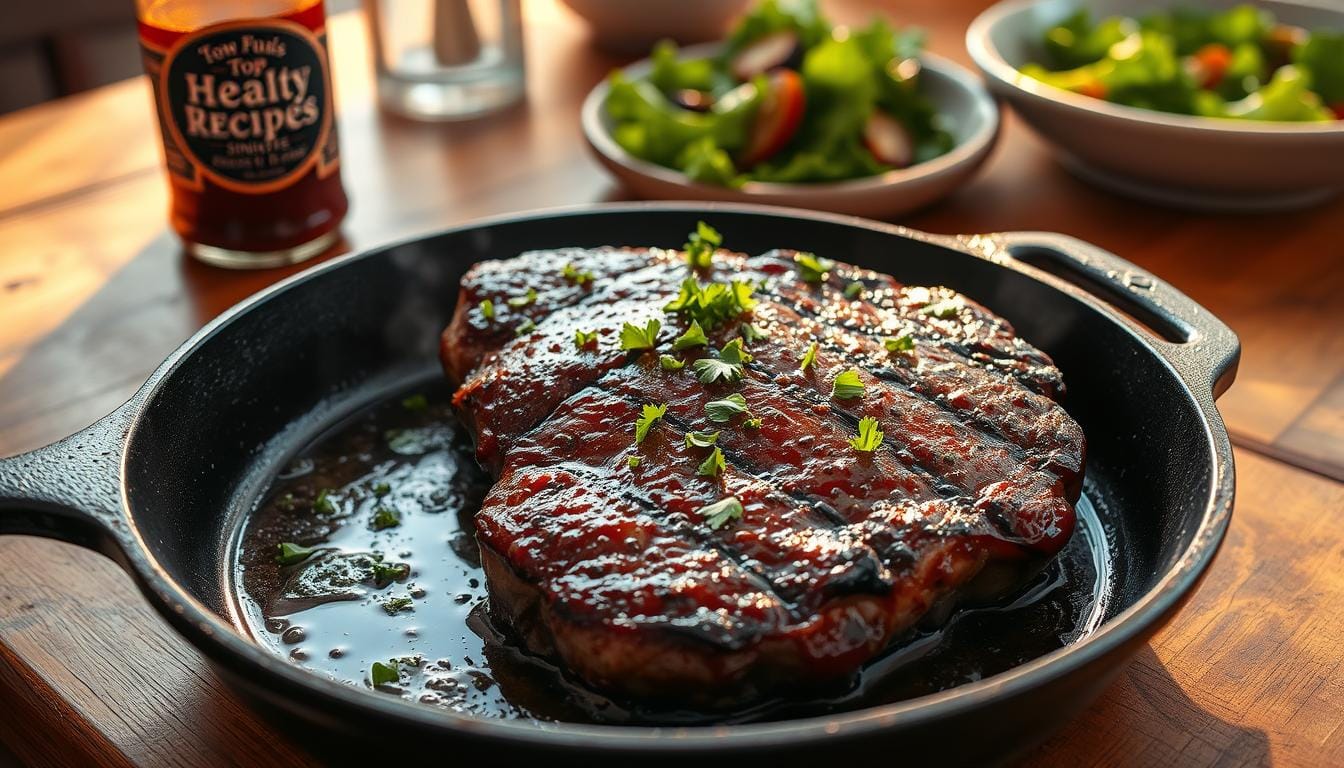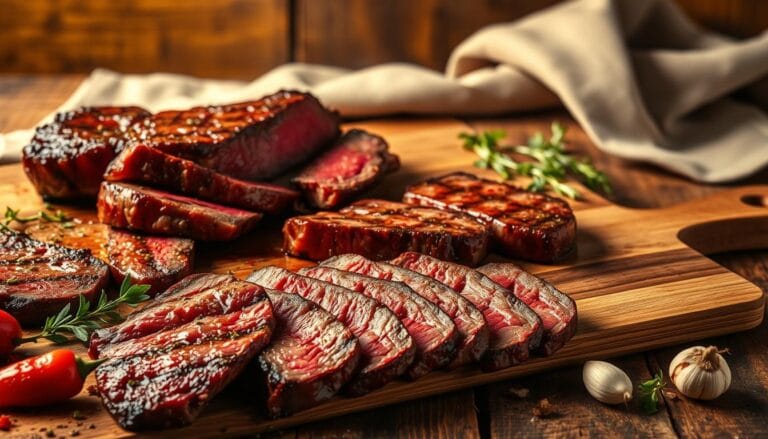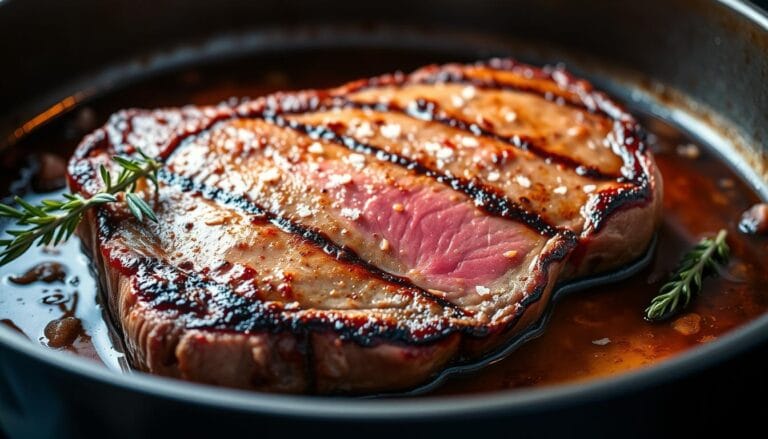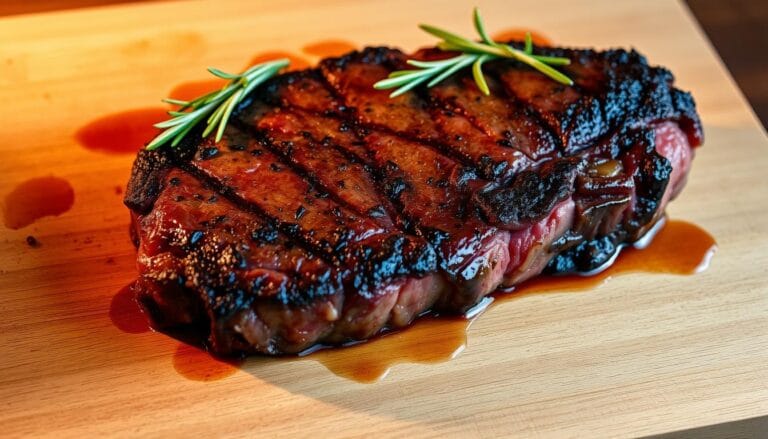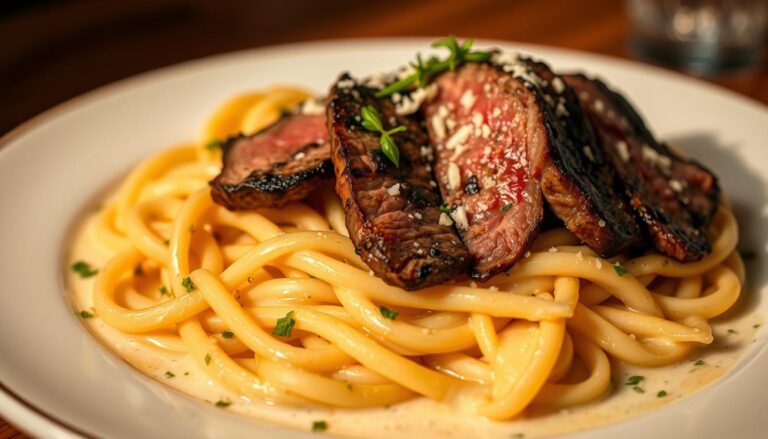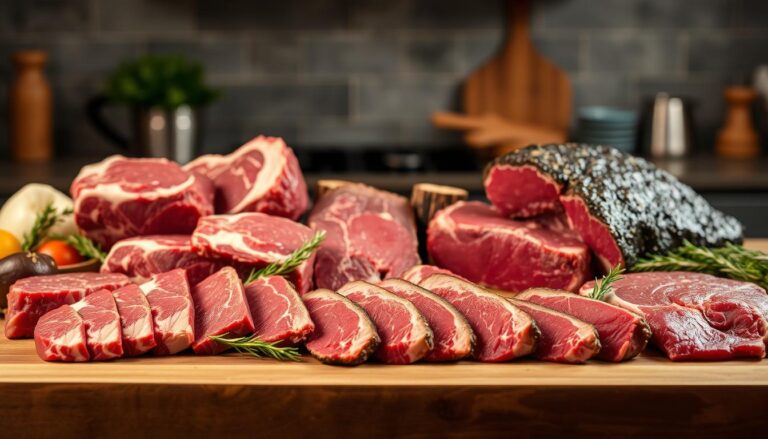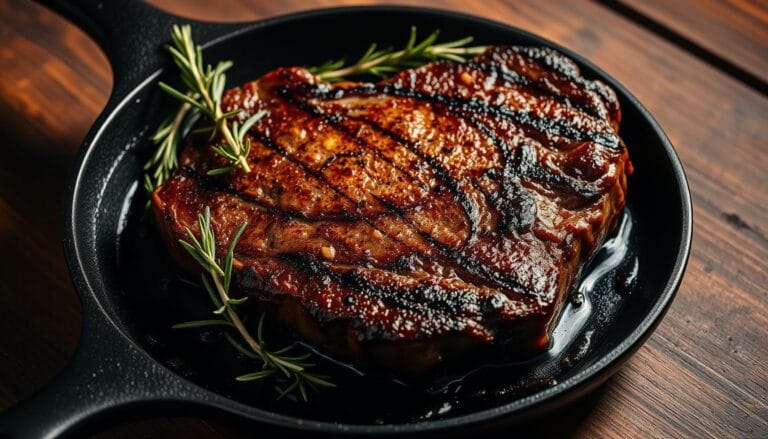Your Go-To Denver Steak Recipe for Juicy, Tender Beef Perfection
Table of Contents
Your Go-To Denver Steak Recipe for Juicy, Tender Beef Perfection
Ready to take your grilling to the next level with a special cut of beef? The Denver steak is a exceptionally tender gem. It comes from the chuck section and is known for its rich flavor and tender texture. It’s perfect for any meal.
Don’t worry if cooking Denver steak seems hard. With the right tips, you can make it juicy, tender beef perfection every time. This guide will show you how to pick, prepare, and cook Denver steak to perfection.
Key Takeaways
- Discover the unique qualities of Denver steak and why it’s a great choice for grilling.
- Learn how to select the perfect Denver steak for your next meal.
- Master the art of preparing Denver steak for cooking.
- Understand the best cooking techniques to achieve tender and juicy results.
- Get tips on serving and pairing Denver steak for a memorable dining experience.
What is Denver Steak?
Denver steak is a special cut of beef known for its rich marbling and tender texture. It has become popular in recent years for its unique taste and texture.
The story of Denver steak starts with its discovery. It was named during the Beef Checkoff Program’s research in the early 2000s. It comes from the chuck primal of the cow, from the serratus ventralis muscle under the blade.
Origin of Denver Steak
The discovery of Denver steak was part of a bigger effort to find and promote underused beef cuts. The Beef Checkoff Program’s research found this cut to be tender and rich in marbling.
- Identified during the Beef Checkoff Program’s research
- Named in the early 2000s
- Derived from the chuck primal
Characteristics of Denver Steak
Denver steak stands out for several reasons. It is known for its:
- Rich marbling, which makes it tender and flavorful
- Rectangular shape, making it visually appealing
- Moderate thickness, for even cooking
Despite being from the chuck section, known for tougher cuts, Denver steak is the fourth most tender beef cut. This makes it a great choice for those looking for a tender steak without the high price of premium cuts.
Knowing these characteristics is key to cooking Denver steak right. The rich marbling means it will be flavorful and tender when cooked well.
Why Choose Denver Steak?
Denver steak is a top choice for those looking for a quality steak without spending a lot.
Denver steak is getting more attention for its amazing qualities. It’s a favorite among steak lovers. Here’s why it should be on your list of things to try.
Flavor Profile
The Denver steak has a rich, beefy taste. This comes from its part of the cow and its marbling. It’s tender and juicy, with a hint of butteriness.
The unique marbling of Denver steak contributes to its rich flavor. When cooked, the fat melts. This spreads the flavors evenly, making each bite tender and tasty.
Cost-Effectiveness
Denver steak is also great because it’s affordable. It’s as tender and flavorful as more expensive cuts like ribeye or strip steak. But it costs less, making it a smart choice for steak fans.
The table below shows how Denver steak compares to other popular cuts in terms of price:
| Steak Cut | Average Price per Pound | Tenderness | Flavor Profile |
|---|---|---|---|
| Denver Steak | $15-$25 | High | Rich, Beefy |
| Ribeye | $20-$35 | High | Rich, Marbled |
| Strip Steak | $25-$40 | High | Lean, Beefy |
Versatility in Cooking
Denver steak is also versatile in cooking. It works well with quick high-heat cooking or slower methods to bring out its flavors. It’s a great addition to your cooking skills.
Some popular cooking methods for Denver steak include grilling, pan-searing, and roasting. Each method highlights different flavors of the steak. You can try different ways to find your favorite.
Essential Ingredients for Your Recipe
The secret to a perfect Denver steak recipe is in the ingredients. To make a meal unforgettable, knowing what makes a great Denver steak is key.
Choosing the Right Cut of Meat
Quality meat is essential for Denver steak. Look for a cut that’s well-marbled for tenderness and flavor. Your steak should be 1 to 1.5 inches thick. Ask a butcher to cut it to your size if needed.
Make sure the meat is a rich, red color. This shows it’s fresh and of high quality.
Marinades and Seasonings
Choosing the right marinades and seasonings is important. Start with salt and pepper. Garlic adds depth, while rosemary and thyme bring a savory aroma.
For a marinade, mix soy sauce, Worcestershire sauce, olive oil, and lemon juice or vinegar. These ingredients tenderize the meat and boost its flavor.
Additional Ingredients for Sides
Great Denver steak meals have sides that complement the steak. Roasting vegetables like asparagus or Brussels sprouts with olive oil, salt, and pepper is simple yet tasty. A fresh salad with mixed greens, cherry tomatoes, and a light vinaigrette adds a refreshing touch.
For a heartier side, try roasted or mashed potatoes. They pair well with your Denver steak.
Preparing Your Denver Steak
To make your Denver steak tender and flavorful, proper preparation is key. This includes a few important steps. These steps will help you cook a perfect Denver steak.
Trimming Excess Fat
Trimming excess fat from your Denver steak is a delicate task. You need to remove enough fat to prevent flare-ups but keep the internal marbling. This marbling adds to the steak’s tenderness and flavor. Use a sharp knife to carefully trim the fat, avoiding cutting too deeply into the meat.
Chef Gordon Ramsay once said, “You can’t cook a bad piece of meat well, but you can cook a good piece badly.” This shows how important starting with good meat is. Trimming excess fat is not just for looks; it also impacts the steak’s flavor and cooking.
Marinating Techniques
Marinating your Denver steak can enhance its flavor. The marinating time can range from 30 minutes to overnight, depending on the marinade. Make sure the container is big enough to hold the steak and marinade, ensuring even coating.
- For a quick marinade, use a mix with acidic ingredients like vinegar or citrus juice.
- For a longer marinade, use a mix with more oil and spices, letting it sit overnight in the fridge.
Even distribution of the marinade is key for flavorful bites. If using a dry rub, coat the steak evenly on all sides.
Ideal Temperature for Cooking
Bringing your Denver steak to room temperature before cooking is vital. It ensures even cooking and better browning. Let the steak sit on the counter for 30 to 45 minutes before cooking. This simple step greatly improves the dish’s quality.
“The perfect steak is all about the balance of flavor, tenderness, and texture. Bringing the steak to room temperature is a simple yet vital step in achieving this balance.”
By following these preparation steps, you’ll be well on your way to cooking a delicious Denver steak that’s cooked to perfection.
Cooking Methods for Denver Steak
Learning to cook Denver steak is all about the right methods. Whether you’re a pro or just starting, the right technique makes a big difference. We’ll look at grilling, pan-searing, and roasting to help you cook it perfectly.
Grilling Tips and Technique
Grilling Denver steak gives it a nice char and a tender inside. First, heat your grill to 450-500°F. Then, cook the steak for 4-5 minutes per side for medium-rare. To get those cool grill marks, turn the steak 90 degrees after 2 minutes on the first side.
Pan-Searing Methods
Pan-searing Denver steak makes it crispy on the outside and juicy inside. Use a cast-iron skillet and heat it high. Choose a high smoke point oil like avocado oil to avoid burning.
Pat the steak dry before searing for a great crust. Cook for 3-4 minutes per side for medium-rare. Make sure not to overcrowd the pan for even cooking.
Roasting Instructions
Roasting is perfect for thicker Denver steak cuts. Start by searing the steak in a hot skillet. Then, move it to a preheated oven at 375-400°F.
Use an oven-safe pan and add garlic and thyme for extra flavor. Roasting times depend on the steak’s thickness and your desired doneness. Roast for 8-12 minutes after searing for medium-rare. Let it rest before slicing to keep the juices in.
Desired Doneness Levels
Getting your Denver steak just right is key. It’s easier than you might think. The doneness of a steak is all about its internal temperature. You can check this with a meat thermometer.
Knowing the different doneness levels and how to get them will make you a pro at cooking Denver steak.
Understanding Meat Temperatures
The internal temperature of a steak shows its doneness. Here’s a chart for different levels:
- Rare: 120-125°F – The steak is red and juicy, with a warm center.
- Medium-rare: 130-135°F – It’s pink all over, with a bit of red in the middle.
- Medium: 140-145°F – It has a mix of pink and cooked meat.
- Medium-well: 150-155°F – It’s slightly pink in the center.
- Well-done: 160°F+ – It’s fully cooked, with no pink left.
How to Use a Meat Thermometer
A meat thermometer is the best way to check your Denver steak’s doneness. To use it right, stick it into the thickest part of the steak. Make sure it’s not near any bone or fat.
There are instant-read and leave-in thermometers. It’s important to calibrate your thermometer. You can do this by putting it in ice water and setting it to 32°F.
Tips for Achieving Perfect Doneness
Getting perfect doneness is more than just the right temperature. Carryover cooking is important to know. It’s when the steak keeps cooking after it’s off the heat.
To fix this, take your steak off the heat 5-10°F before your target. Letting your steak rest after cooking helps the juices spread out. This makes it more tender and flavorful.
Also, adjust cooking times based on your steak’s thickness. This is key for perfect doneness.
Serving Suggestions
Finishing your Denver steak meal with the right sides and presentation is key. A well-rounded meal not only fills your belly but also pleases your senses. It offers a mix of flavors and textures.
Best Side Dishes to Pair
Choosing the right side dishes can take your Denver steak to new heights. Here are some great options:
- Roasted Vegetables: Try asparagus, Brussels sprouts, and carrots roasted to perfection. They contrast nicely with the rich steak.
- Starches: Garlic mashed potatoes, crispy roasted potatoes, or wild rice are excellent choices. They complement the savory steak flavor.
- Fresh Elements: A simple green salad or grilled corn on the cob adds a fresh twist to your meal.
Creative Toppings and Sauces
Make your Denver steak even better with creative toppings and sauces. Here are some ideas:
- Compound Butters: Try herb, blue cheese, or chipotle butter for a rich, complex flavor.
- Classic Sauces: Chimichurri, béarnaise, or a red wine reduction can take the dish to the next level.
- Garnishes: Caramelized onions, sautéed mushrooms, or crispy shallots are great toppings.
Presentation Tips for Your Dish
The way you present your Denver steak can make it even more appealing. Here are some tips:
- Slice Against the Grain: This ensures the steak is tender.
- Arrange Components Visually: Balance the components on the plate for a visually appealing dish.
- Add Finishing Touches: Fresh herbs or flaky salt can add a nice finish.
Storing Leftover Denver Steak
Storing leftover Denver steak right is key to keeping its quality. After cooking a delicious Denver steak, you’ll want your leftovers to taste just as good. Knowing how to refrigerate and reheat them is important.
Cooling and Storage Techniques
First, cool the leftover steak to room temperature within two hours. This stops bacteria from growing. Then, wrap it tightly in plastic wrap or foil, or use an airtight container.
This keeps moisture out and prevents other flavors from mixing with the steak. Store it in the fridge, away from raw foods to avoid contamination. Place it on a middle or bottom shelf for a consistent temperature.
Reheating for Optimal Flavor
Reheating Denver steak without drying it out can be tricky. But, there are ways to keep it flavorful. Try reheating it in a low-temperature oven at 275°F until it’s just warm.
If you have a sous vide machine, you can heat it to the exact temperature. For a quicker method, reheat it on the stovetop with some broth or sauce. This keeps it moist. If all else fails, microwaving is an option. Just heat it at 30% power in short bursts, checking often to avoid overcooking.
Flavor Enhancements
Make your Denver steak even better with different flavors. Herbs, spices, marinades, and sauces can make a big difference. They can turn a good steak into an amazing meal.
Herb and Spice Combinations
Try out different herb and spice mixes to boost your steak’s taste. Here are four great options:
- Classic Steakhouse: A mix of salt, pepper, garlic powder, and onion powder adds depth without overpowering the steak.
- Mediterranean: Oregano, rosemary, lemon zest, and garlic create a bright, herby flavor that complements the steak’s richness.
- Southwestern: Cumin, chili powder, coriander, and brown sugar give a bold, slightly spicy taste that goes well with grilled veggies.
- Asian-Inspired: Five-spice powder, ginger, garlic, and brown sugar offer a sweet and savory flavor with a hint of spice.
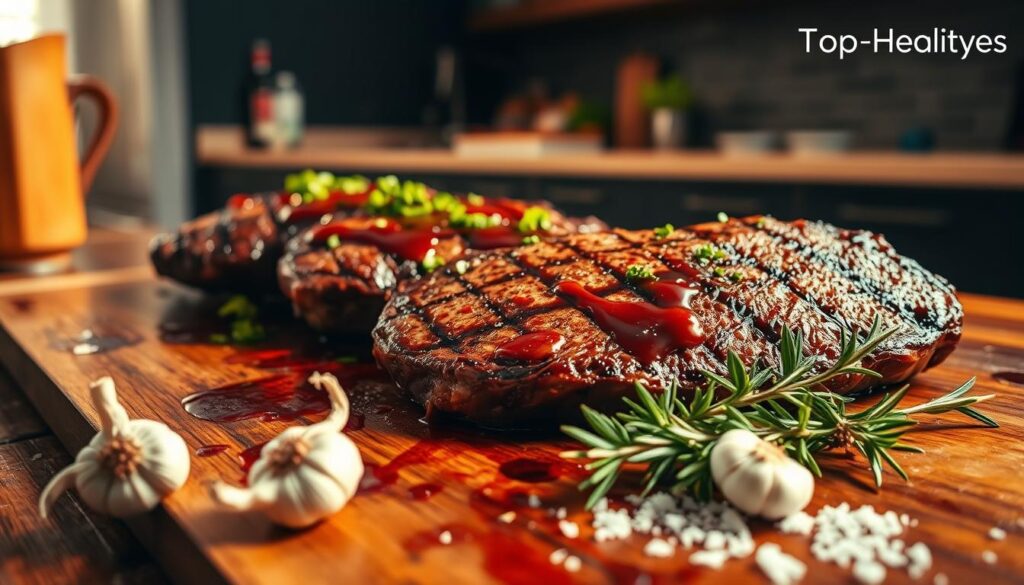
Suggested Marinade Recipes
Marinating your Denver steak adds moisture and flavor. Here are some marinade recipes to try:
- Balsamic-Rosemary: Mix balsamic vinegar, olive oil, minced rosemary, garlic, salt, and pepper. Marinate for at least 2 hours.
- Soy-Ginger: Soy sauce, grated ginger, garlic, brown sugar, and sesame oil make a great marinade. Marinate for 4-6 hours.
- Citrus-Herb: Combine citrus juice, olive oil, chopped herbs, garlic, salt, and pepper. Marinate for 2-4 hours.
- Bourbon-Brown Sugar: Bourbon, brown sugar, Dijon mustard, Worcestershire sauce, garlic, and thyme make a tasty marinade. Marinate for 4-6 hours.
Recommended Sauces and Accompaniments
The right sauce can take your Denver steak to the next level. Try these recipes:
- Chimichurri: A bright Argentinean sauce with parsley, oregano, garlic, red pepper flakes, red wine vinegar, and olive oil. Serve on the side.
- Horseradish Cream: Sour cream, prepared horseradish, lemon juice, and chives make a tangy sauce. Serve chilled.
- Blue Cheese Butter: Softened butter, crumbled blue cheese, parsley, and black pepper make a rich topping. Melt on top of the steak.
- Mushroom Sauce: Sauté mushrooms in butter until tender, then add heavy cream and Dijon mustard. Simmer until thickened. Serve over the steak.
By using these flavor enhancements, you can make a memorable Denver steak experience. It will impress your family and friends.
Common Mistakes to Avoid
To cook a Denver steak perfectly, you must avoid common mistakes. Cooking Denver steak is easy if you know the pitfalls. These mistakes can ruin your steak.
Overcooking the Steak
Denver steak is lean and can dry out quickly if overcooked. Unlike fatty cuts, it doesn’t stay juicy when cooked too long. To prevent this, keep a close eye on the steak’s temperature.
Use a meat thermometer for the most accurate reading. You can also check doneness by touch. A rare steak feels soft, while a well-done steak is hard.
| Doneness Level | Internal Temperature (°F) |
|---|---|
| Rare | 120-130 |
| Medium Rare | 130-135 |
| Medium | 140-145 |
| Well Done | 160+ |
Skipping the Rest Period
It’s tempting to cut into your steak right away. But, skipping the rest period can make it less flavorful and tender. Resting lets the juices spread evenly, making each bite juicy and flavorful.
To rest your steak, cover it with foil and let it sit for 5-10 minutes. This simple step greatly improves your steak’s quality.
Choosing Low-Quality Meat
The quality of your Denver steak is key to a great meal. Look for good marbling, a bright red color, and a recent packaging date. Even on a budget, you can find high-quality steak.
Buy from trusted sources or butchers who know their meat. Knowing what to look for helps you make a better choice. This way, you’ll enjoy a better dining experience.
Denver Steak for Different Occasions
Denver steak is great for any meal, from a quick dinner to a fancy party. Its rich flavor and tender texture fit many tastes. It’s a great choice for your cooking.
Quick Weeknight Dinner Ideas
For a fast dinner, pan-sear your Denver steak with simple seasonings. This cooks it in under 30 minutes, perfect for busy nights. Serve it with microwave-steamed veggies or a pre-made side for a complete meal.
- Season the steak with salt, pepper, and herbs.
- Sear the steak in a hot skillet for 3-4 minutes per side.
- Serve with roasted veggies or a salad.
Fancy Dinner Party Options
For a dinner party, add a complex marinade or rich sauce to your Denver steak. A beautifully presented dish impresses your guests. Serve it with sides like roasted veggies or creamy mashed potatoes. Don’t forget to suggest a wine pairing.
“The key to a successful dinner party is not just the taste, but the presentation. Make sure to plate your Denver steak attractively, garnished with fresh herbs and accompanied by a well-chosen wine.”
| Menu Item | Description | Preparation Time |
|---|---|---|
| Denver Steak | Pan-seared with a garlic-herb marinade | 20 minutes |
| Roasted Vegetables | Seasonal vegetables tossed with olive oil and herbs | 15 minutes |
| Mashed Potatoes | Creamy potatoes infused with garlic and parmesan | 25 minutes |
Meal Prep Ideas for Busy Schedules
Denver steak is perfect for meal prep. Cook it in advance and portion it out for quick, healthy meals. Slice the steak and add it to salads, sandwiches, or grain bowls.
- Cook the Denver steak to your desired level of doneness.
- Slice the steak into thin strips for easy incorporation into various meals.
- Store the cooked steak in airtight containers in the refrigerator for up to 3 days.
Nutritional Information
Knowing the nutritional value of Denver steak helps you make smart choices for your diet. It’s tender, flavorful, and packed with nutrients. This makes it a great addition to a healthy meal plan.
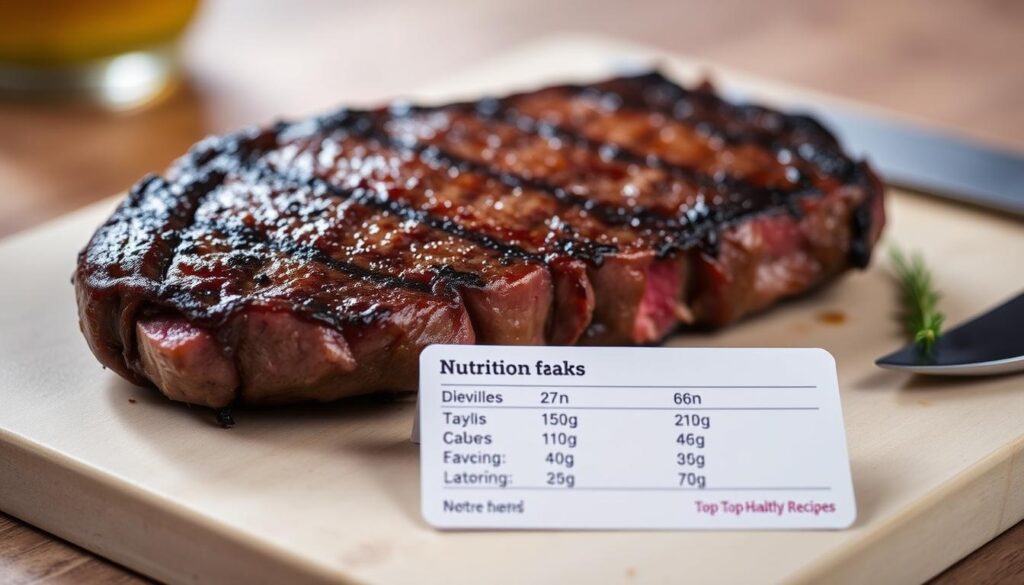
Benefits for Your Health
Denver steak is a top source of protein, with about 25 grams in a 3-ounce serving. It’s also full of iron, zinc, and B vitamins, like B12. These nutrients boost energy, support the immune system, and help make red blood cells.
It has a better fat profile than other beef cuts. This makes it leaner, perfect for those watching their fat intake but wanting to keep the flavor.
The high protein content in Denver steak is great for muscle growth and repair. It’s perfect for those who are active. Plus, the iron and zinc in it boost your immune system and overall health.
Appropriate Serving Sizes
It’s important to know the right serving sizes for Denver steak. A standard serving is 3 to 6 ounces per person, based on your needs. A 3-ounce serving is about the size of a deck of cards.
This helps you enjoy Denver steak in different diets, like high-protein, low-carb, and balanced plate methods.
- For a high-protein diet, pair Denver steak with protein-rich sides.
- For a low-carb diet, choose vegetable sides and avoid carbs.
- For a balanced plate, put half the plate in veggies, a quarter in protein (Denver steak), and a quarter in whole grains or starchy veggies.
Creating Balanced Meals with Vegetables
Pairing Denver steak with vegetables is key to a nutritious meal. Vegetables add fiber, vitamins, and minerals. They also enhance the steak’s flavor and texture.
Try pairing it with roasted veggies like asparagus, Brussels sprouts, or bell peppers. These are not only healthy but also tasty. Roasting them in the oven with the steak is an efficient way to cook.
| Vegetable | Nutritional Benefit | Cooking Method |
|---|---|---|
| Asparagus | Rich in Vitamin C and fiber | Roasting |
| Brussels Sprouts | High in Vitamins C and K | Roasting or sautéing |
| Bell Peppers | Rich in Vitamin C and antioxidants | Grilling or sautéing |
By understanding Denver steak’s nutritional benefits and how to balance it with other foods, you can enjoy a healthy and tasty meal. It fits your dietary needs perfectly.
Frequently Asked Questions
Denver steak is a new cut in cooking that raises many questions. People want to know how to cook it and what it’s like. Here are some common questions to help you enjoy your Denver steak.
Is Denver Steak Tender?
Denver steak is very tender, the fourth most tender cut of beef. It’s as tender as a ribeye or sirloin. To keep it tender, slice it against the grain and cook it right.
Proper slicing and cooking are key to tenderness. Slice against the grain to avoid chewiness. This makes the steak feel softer and more enjoyable to eat.
How to Tell if Steak is Fresh?
Checking if your Denver steak is fresh is important for a great meal. Look for these signs:
- Color: It should be bright cherry-red. Stay away from brown or gray.
- Smell: It should smell neutral or slightly sweet. Sour or bad smells mean it’s spoiled.
- Texture: It should feel firm and a bit moist, not slimy.
- Packaging Integrity: Make sure the packaging is not damaged.
- Date Considerations: Check the “use by” or “sell by” date.
Can Denver Steak Be Grilled from Frozen?
While thawing is best, you can grill Denver steak from frozen. Use indirect heat first to thaw, then direct heat to sear. But thawing is better for even cooking and texture.
“The key to grilling frozen Denver steak lies in patience and the right technique. Start with indirect heat to safely thaw the steak, then sear it over direct heat to lock in the juices.”
Conclusion: Elevate Your Dinner with Denver Steak
Learning to cook Denver steak can make your dinner unforgettable. This beef is known for its rich taste and soft texture. By following the steps in this article, you’re ready to make delicious Denver steak recipes.
Key Takeaways
This article covers Denver steak’s unique traits, best cooking methods, and how to serve it. You now know how to pick the right meat, prepare it, and cook it to perfection. With these tips, you can make a tasty meal with confidence.
Experimenting with Flavor
Now, it’s time to try new flavors and techniques. Mix different marinades, seasonings, and sauces to make your own Denver steak recipes. As you keep practicing, you’ll get better at making amazing dishes.
Expand your skills by trying other beef cuts and cooking ways. With time and effort, you’ll become a skilled griller and chef. You’ll impress everyone with your cooking.
FAQ
Is Denver Steak Tender?
How to Tell if Steak is Fresh?
Can Denver Steak Be Grilled from Frozen?
How to Cook Denver Steak?
What are the Best Denver Steak Recipes?
What are the Characteristics of Denver Steak?
For more cooking tips, stay connected with us. We also recommend the cookbook Skinnytaste Simple: Easy, Healthy Recipes with 7 Ingredients or Fewer
For more Recipes about Steak ?
Did You try our recipe ?
There are no reviews yet. Be the first one to write one.
